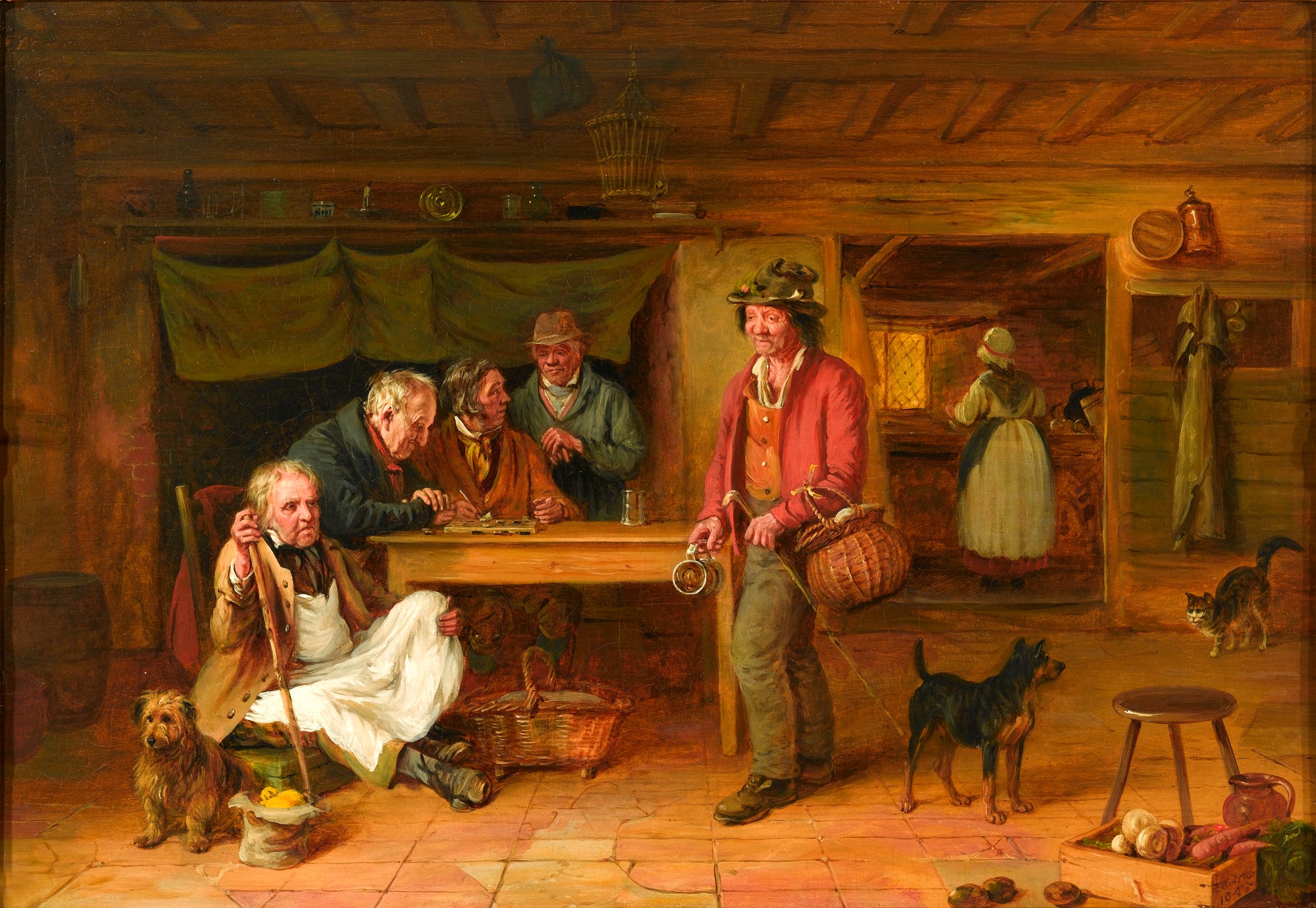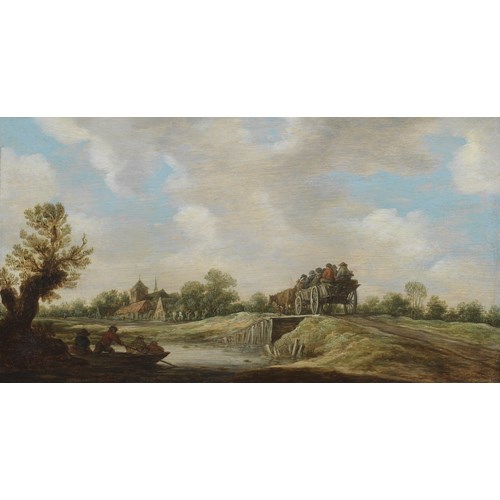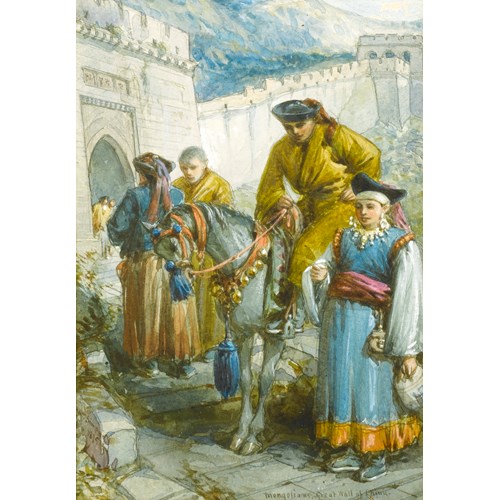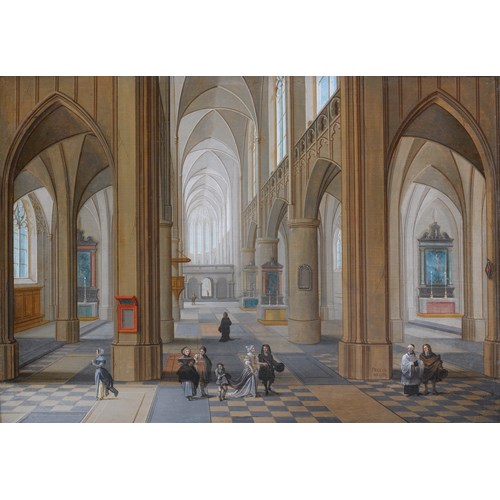Marketplace
The Turk’s Head Inn, Eton
Edmund Bristow
The Turk’s Head Inn, Eton
Date 1845
Epoque 1750-1850, 19th century
Origine England
Medium Oil on panel
Dimension 33 x 48.3 cm (13 x 19 inches)
A small group gathers in the humble interior of The Turk’s Head in Eton, their weather-beaten faces and well-worn clothing perfectly suited to the homely surroundings. A beggar in a tattered hat, holding a cane in one hand and an empty beer mug in the other, approaches the table where four others sit. Two are absorbed in a game of checkers while a third stands behind and observes. The fourth, seated low to the ground, gazes away from his companions with a vacant expression. He appears weary and wears a white apron, suggesting he may be taking a break from work. A faithful terrier sits by his side. Another dog stands guard on the right of the composition warily eyeing a cat that furtively creeps into the room. Through a doorway, a woman can be seen washing up with her back turned towards the viewer. Charming details such as the overflowing box of vegetables in a corner and the assortment of decorative items on the mantle shelf give the painting added character. The highly individual faces of the men are beautifully observed and expressively detailed.
The Turk’s Head in Eton dates from 1520 and was an alehouse at the time that Edmund Bristow depicted it. In 1878, it was turned into the Three Lilies Coffee Tavern, in order to provide refreshment without the temptation of alcohol and thereby attract a more respectable crowd. In 1845, however, when The Turk’s Head, Eton was painted, the clientele was clearly staunchly male and working class, their furrowed brows and decrepit appearances suggesting lives filled with heavy toil.
Bristow is well-regarded for his small scale paintings of a type that was increasingly popular in the late eighteenth and early nineteenth centuries, prompted by the rise of the middle class who desired affordable pictures to decorate their homes. A number of such paintings were genre scenes designed with a moralising message, such as Bristow’s The Interrupted Wedding, in the Denver Art Museum, which depicts a bridegroom being accosted by the mother of a forlorn young woman with two children in the background. From the animated gestures and varying indications of anger and dismay evident on the group’s faces, it is understood that the young man has fathered the two illegitimate children and must be held responsible. Although the present work lacks this didactic element, the range of expression and the details of the painting are equally engrossing.
Bristow was the son of a heraldic painter, from whom he received his artistic training. He became primarily a sporting and animal painter and his sympathetic rendering of animals is consistent throughout his oeuvre. His output also included landscape views of Windsor and Eton College and occasional genre scenes. He lived at Windsor all his life, and was patronised by Princess Elizabeth (1770-1840) and the Duke of Clarence, later William IV (1765-1837). He was a friend and possibly also a mentor of Sir Edwin Landseer (1802-1873). Bristow exhibited at the Royal Academy in his early years, between 1809 and 1820, while towards the end of his life he became increasingly eccentric and reclusive, refusing to part with his work.
The Turk’s Head in Eton dates from 1520 and was an alehouse at the time that Edmund Bristow depicted it. In 1878, it was turned into the Three Lilies Coffee Tavern, in order to provide refreshment without the temptation of alcohol and thereby attract a more respectable crowd. In 1845, however, when The Turk’s Head, Eton was painted, the clientele was clearly staunchly male and working class, their furrowed brows and decrepit appearances suggesting lives filled with heavy toil.
Bristow is well-regarded for his small scale paintings of a type that was increasingly popular in the late eighteenth and early nineteenth centuries, prompted by the rise of the middle class who desired affordable pictures to decorate their homes. A number of such paintings were genre scenes designed with a moralising message, such as Bristow’s The Interrupted Wedding, in the Denver Art Museum, which depicts a bridegroom being accosted by the mother of a forlorn young woman with two children in the background. From the animated gestures and varying indications of anger and dismay evident on the group’s faces, it is understood that the young man has fathered the two illegitimate children and must be held responsible. Although the present work lacks this didactic element, the range of expression and the details of the painting are equally engrossing.
Bristow was the son of a heraldic painter, from whom he received his artistic training. He became primarily a sporting and animal painter and his sympathetic rendering of animals is consistent throughout his oeuvre. His output also included landscape views of Windsor and Eton College and occasional genre scenes. He lived at Windsor all his life, and was patronised by Princess Elizabeth (1770-1840) and the Duke of Clarence, later William IV (1765-1837). He was a friend and possibly also a mentor of Sir Edwin Landseer (1802-1873). Bristow exhibited at the Royal Academy in his early years, between 1809 and 1820, while towards the end of his life he became increasingly eccentric and reclusive, refusing to part with his work.
Date: 1845
Epoque: 1750-1850, 19th century
Origine: England
Medium: Oil on panel
Signature: Signed and dated ‘E Bristow/1845’ (lower right).
Dimension: 33 x 48.3 cm (13 x 19 inches)
Provenance: with David Messum, Beaconsfield
Plus d'œuvres d'art de la Galerie









